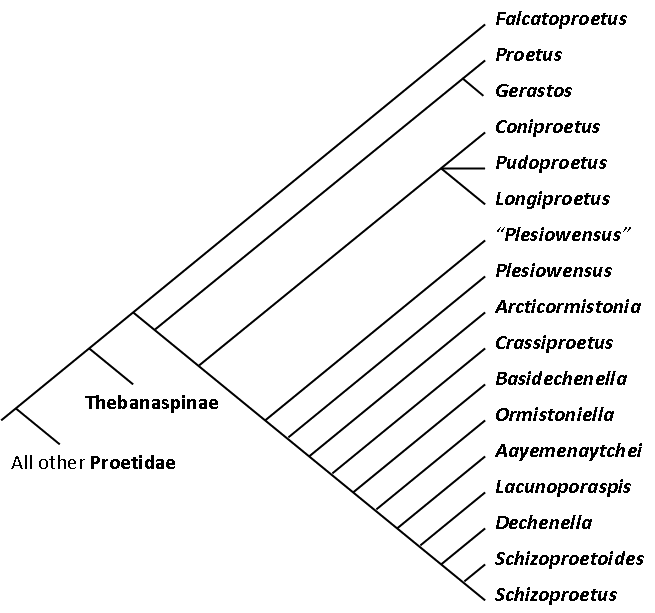Proetus (trilobite) on:
[Wikipedia]
[Google]
[Amazon]
''Proetus'' is a
/ref>
 The generic name commemorates
The generic name commemorates
 ''Proetus'' is the
''Proetus'' is the
genus
Genus ( plural genera ) is a taxonomic rank used in the biological classification of extant taxon, living and fossil organisms as well as Virus classification#ICTV classification, viruses. In the hierarchy of biological classification, genus com ...
of proetid trilobite
Trilobites (; meaning "three lobes") are extinct marine arthropods that form the class Trilobita. Trilobites form one of the earliest-known groups of arthropods. The first appearance of trilobites in the fossil record defines the base of the At ...
found in Silurian
The Silurian ( ) is a geologic period and system spanning 24.6 million years from the end of the Ordovician Period, at million years ago ( Mya), to the beginning of the Devonian Period, Mya. The Silurian is the shortest period of the Paleozo ...
-aged marine strata of Europe
Europe is a large peninsula conventionally considered a continent in its own right because of its great physical size and the weight of its history and traditions. Europe is also considered a Continent#Subcontinents, subcontinent of Eurasia ...
.Storey, Andrew James. Late Silurian trilobite palaeobiology and biodiversity. Diss. University of Birmingham, 2012/ref>
Etymology
Proetus
In Greek mythology, Proetus (; Ancient Greek: Προῖτος ''Proitos'') may refer to the following personages:
*Proetus, king of Argos and Tiryns, son of Abas and twin brother of Acrisius.
*Proetus, a prince of Corinth as the son of Prince T ...
( grc-gre, Προῖτος), a mythical
Myth is a folklore genre consisting of narratives that play a fundamental role in a society, such as foundational tales or origin myths. Since "myth" is widely used to imply that a story is not objectively true, the identification of a narrati ...
king of Argos
Argos most often refers to:
* Argos, Peloponnese, a city in Argolis, Greece
** Ancient Argos, the ancient city
* Argos (retailer), a catalogue retailer operating in the United Kingdom and Ireland
Argos or ARGOS may also refer to:
Businesses
...
and Tiryns
Tiryns or (Ancient Greek: Τίρυνς; Modern Greek: Τίρυνθα) is a Mycenaean archaeological site in Argolis in the Peloponnese, and the location from which the mythical hero Heracles performed his Twelve Labours. It lies south of Myce ...
, son of King Abas of Argo.
Taxonomy
 ''Proetus'' is the
''Proetus'' is the type genus
In biological taxonomy, the type genus is the genus which defines a biological family and the root of the family name.
Zoological nomenclature
According to the International Code of Zoological Nomenclature, "The name-bearing type of a nominal f ...
of the order Proetida
Proetida is an order of trilobite that lived from the Ordovician to the Permian. It was the last order of trilobite to go extinct, finally dying out in the Permian-Triassic extinction event.
Description
These typically small trilobites resem ...
, and of the family
Family (from la, familia) is a Social group, group of people related either by consanguinity (by recognized birth) or Affinity (law), affinity (by marriage or other relationship). The purpose of the family is to maintain the well-being of its ...
Proetidae
Proetidae is a family of proetid trilobites. The first species appeared in the Upper Ordovician, and the last genera survived until the Middle Permian. However, if the closely related family Phillipsiidae is actually a subfamily of Proetidae, t ...
. The genus became a wastebasket taxon
Wastebasket taxon (also called a wastebin taxon, dustbin taxon or catch-all taxon) is a term used by some taxonomists to refer to a taxon that has the sole purpose of classifying organisms that do not fit anywhere else. They are typically defined ...
that held numerous species of similar looking trilobites from the Ordovician to Carboniferous periods. Most of these species have been split off into other genera, leaving only ''P. concinnus'' and ''P. latifrons'' as the only confirmed members.
Distribution
Fossils of thetype species
In zoological nomenclature, a type species (''species typica'') is the species name with which the name of a genus or subgenus is considered to be permanently taxonomically associated, i.e., the species that contains the biological type specimen ...
, ''P. concinnus'', are found in Wenlock-aged marine strata of Sweden
Sweden, formally the Kingdom of Sweden,The United Nations Group of Experts on Geographical Names states that the country's formal name is the Kingdom of SwedenUNGEGN World Geographical Names, Sweden./ref> is a Nordic country located on ...
, Great Britain
Great Britain is an island in the North Atlantic Ocean off the northwest coast of continental Europe. With an area of , it is the largest of the British Isles, the largest European island and the ninth-largest island in the world. It is ...
, Estonia
Estonia, formally the Republic of Estonia, is a country by the Baltic Sea in Northern Europe. It is bordered to the north by the Gulf of Finland across from Finland, to the west by the sea across from Sweden, to the south by Latvia, a ...
, and Germany
Germany,, officially the Federal Republic of Germany, is a country in Central Europe. It is the second most populous country in Europe after Russia, and the most populous member state of the European Union. Germany is situated betwe ...
. Fossils of the other recognized species, ''P. latifrons'', are found in Llandovery-aged marine strata of Ireland
Ireland ( ; ga, Éire ; Ulster Scots dialect, Ulster-Scots: ) is an island in the Atlantic Ocean, North Atlantic Ocean, in Northwestern Europe, north-western Europe. It is separated from Great Britain to its east by the North Channel (Grea ...
and Great Britain.
References
Proetidae Proetida genera Silurian trilobites of Europe Silurian first appearances Silurian extinctions Fossil taxa described in 1831 {{proetida-stub